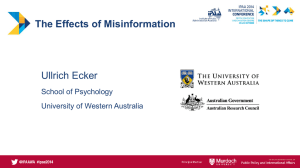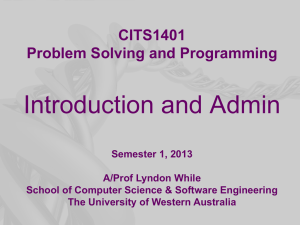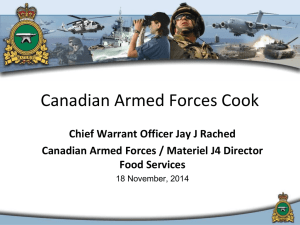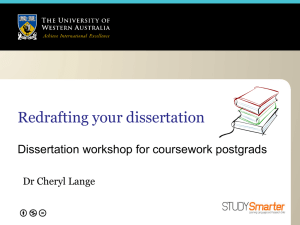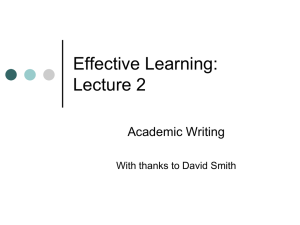Here is a PowerPoint presentation on myth debunking for educators
advertisement
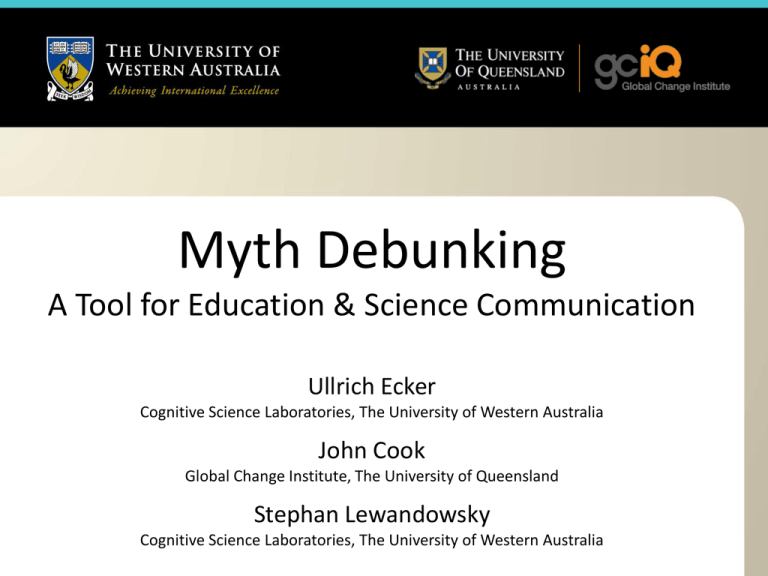
John Cook Myth Debunking Global Change Institute, University of Queensland A Tool for Education & Science Communication Web: http://www.skepticalscience.com Email: john@skepticalscience.com Ullrich Ecker Phone: +61 7 3365 3553 Cognitive Science Laboratories, The University of Western Australia John Cook Global Change Institute, The University of Queensland Stephan Lewandowsky Cognitive Science Laboratories, The University of Western Australia Copyright This presentation is licensed under the Creative Commons Attribution-NonCommercial-ShareAlike 3.0 Unported License. To view a copy of this license, visit http://creativecommons.org/licenses/by-nc-sa/3.0/. You are free to copy, distribute, transmit, and adapt the work, under the following conditions: Attribution — You must attribute the work as specified in the following (but not in any way that suggests that the original authors endorse you or your use of the work): • Cite as Ecker, Cook, & Lewandowsky (2012). Myth Debunking—A Tool for Education & Science Communication. Available at www.cogsciwa.com. • Retain the footer (including university logos) when incorporating individual slides into your presentation/publication. Noncommercial — You may not use this work for commercial purposes. Share Alike — If you alter, transform, or build upon this work, you may distribute the resulting work only under the same or similar license to this one. © Ecker, Cook, & Lewandowsky (2012) ullrich.ecker@uwa.edu.au The Authors Dr Ullrich Ecker is an Australian Postdoctoral Fellow, funded by the Australian Research Council, at the University of Australia’s School of Psychology. He was named Outstanding Young Investigator of 2011 at the University of Western Australia, and was a finalist in the 2012 Western Australia Early Career Scientist of the Year Awards. His research looks at memory updating and the cognitive processing of misinformation. E-mail: ullrich.ecker@uwa.edu.au Web: www.cogsciwa.com John Cook is a Climate Communication Fellow for the Global Change Institute at the University of Queensland. He also runs skepticalscience.com, a website that makes climate science accessible to the general public, for which he received the Australian Museum’s 2011 Eureka Prize for Advancement of Climate Change Knowledge. He is also an Adjunct Lecturer and PhD student at the University of Western Australia. His research looks at the influence of worldview in how we process scientific information. E-mail: j.cook3@uq.edu.au Web: www.skepticalscience.com Dr Stephan Lewandowsky is a cognitive scientist and Winthrop Professor at the University of Australia’s School of Psychology. He is the recipient of a Discovery Outstanding Researcher Award from the Australian Research Council (2011). His research addresses memory updating, the distinction between skepticism and denial, and the role of uncertainty in the climate system. E-mail: stephan.lewandowsky@uwa.edu.au Web: www.cogsciwa.com © Ecker, Cook, & Lewandowsky (2012) ullrich.ecker@uwa.edu.au A Review: Lewandowsky et al. (2012) in Psychological Science in the Public Interest For an authoritative review of the literature on misinformation, please see: Lewandowsky, Ecker, Seifert, Schwarz, & Cook (2012). Misinformation and its correction: Continued influence and successful debiasing. Psychological Science in the Public Interest, 13, 106-131. Abstract: The widespread prevalence and persistence of misinformation in contemporary societies, such as the false belief that there is a link between childhood vaccinations and autism, is a matter of public concern. For example, the myths surrounding vaccinations, which prompted some parents to withhold immunization from their children, have led to a marked increase in vaccine-preventable disease, as well as unnecessary public expenditure on research and public-information campaigns aimed at rectifying the situation. We first examine the mechanisms by which such misinformation is disseminated in society, both inadvertently and purposely. Misinformation can originate from rumors but also from works of fiction, governments and politicians, and vested interests. Moreover, changes in the media landscape, including the arrival of the Internet, have fundamentally influenced the ways in which information is communicated and misinformation is spread. We next move to misinformation at the level of the individual, and review the cognitive factors that often render misinformation resistant to correction. We consider how people assess the truth of statements and what makes people believe certain things but not others. We look at people’s memory for misinformation and answer the questions of why retractions of misinformation are so ineffective in memory updating and why efforts to retract misinformation can even backfire and, ironically, increase misbelief. Though ideology and personal worldviews can be major obstacles for debiasing, there nonetheless are a number of effective techniques for reducing the impact of misinformation, and we pay special attention to these factors that aid in debiasing. We conclude by providing specific recommendations for the debunking of misinformation. These recommendations pertain to the ways in which corrections should be designed, structured, and applied in order to maximize their impact. Grounded in cognitive psychological theory, these recommendations may help practitioners—including journalists, health professionals, educators, and science communicators—design effective misinformation retractions, educational tools, and public-information campaigns. © Ecker, Cook, & Lewandowsky (2012) ullrich.ecker@uwa.edu.au Misinformation: Why is it important? • Decisions are based on information • Misinformation leads to bad decisions • Simple retractions of misinformation are inefficient © Ecker, Cook, & Lewandowsky (2012) ullrich.ecker@uwa.edu.au Inefficient Retractions • Example 1 – USA, 2003: Many tentative media reports of WMD discoveries during Iraq invasion – All retracted – Nonetheless, substantial proportion of populace continued to believe that WMD’s had been found (Kull et al., 2003) © Ecker, Cook, & Lewandowsky (2012) ullrich.ecker@uwa.edu.au Inefficient Retractions • Example 2 – UK, 1998: Claim that a certain vaccine causes autism – Retracted – Nonetheless, substantial and long-lasting drop in vaccination rates, leading to hospitalization and even death of many children (Owens, 2002; Poland & Jacobsen, 2011) © Ecker, Cook, & Lewandowsky (2012) ullrich.ecker@uwa.edu.au …maybe people missed the retraction? • Lab research shows that people continue to rely on misinformation even – when they understand the retraction – when they correctly remember the retraction – when they have no reason to believe one event version or the other (Ecker et al., 2010, 2011a, 2011b; Johnson & Seifert, 1994) © Ecker, Cook, & Lewandowsky (2012) ullrich.ecker@uwa.edu.au Example (Ecker et al., 2011b; Johnson & Seifert, 1994; Wilkes & Leatherbarrow, 1988) • People first read: – “…Negligent storage of gas cylinders caused a fire…” • Then the retraction: – “…Police have confirmed there was no evidence of gas cylinders or negligence causing the fire…” © Ecker, Cook, & Lewandowsky (2012) ullrich.ecker@uwa.edu.au Example ( Ecker et al., 2011b) • Verbatim responses of a person to later questions: – What was the content of the police message? • “That there were no gas cylinders involved.” – What caused the explosions? • “The gas cylinders.” © Ecker, Cook, & Lewandowsky (2012) ullrich.ecker@uwa.edu.au Continued Influence after a Retraction References to a Piece of (Mis)Information Ecker et al. (2011a) 5 4 3 No-Retraction Retraction Retraction+Alternative 2 1 0 © Ecker, Cook, & Lewandowsky (2012) ullrich.ecker@uwa.edu.au Why? • Why do people find it difficult to “unlearn”, i.e. “remove” misinformation? © Ecker, Cook, & Lewandowsky (2012) ullrich.ecker@uwa.edu.au Retractions Create a Gap MYTH Removing a myth leaves a gap People hate gaps! “Removed” misinformation is actually still in memory, and people use it even when they know it is wrong! © Ecker, Cook, & Lewandowsky (2012) ullrich.ecker@uwa.edu.au Fill the Gap FACT …Unless… The gap can be filled with plausible alternative information Replace with alternative narrative © Ecker, Cook, & Lewandowsky (2012) ullrich.ecker@uwa.edu.au Example (Ecker et al., 2011b; Johnson & Seifert, 1994) • People first read: – “…Negligent storage of gas cylinders caused a fire…” • Then a retraction including a causal alternative: – “…Police have confirmed there was no evidence of gas cylinders or negligence causing the fire…” – “…but arson materials have been found…” © Ecker, Cook, & Lewandowsky (2012) ullrich.ecker@uwa.edu.au Continued Influence after a Retraction References to a Piece of (Mis)Information Ecker et al. (2011a) 5 4 3 No-Retraction Retraction Retraction+Alternative 2 1 0 © Ecker, Cook, & Lewandowsky (2012) ullrich.ecker@uwa.edu.au Element 1 of an Effective Debunking Create a gap with a retraction © Ecker, Cook, & Lewandowsky (2012) Fill the gap with a factual alternative ullrich.ecker@uwa.edu.au The Curiosity Gap • If you retract a myth in someone’s head, the gap is obvious. • But sometimes people are unaware of their knowledge gaps. © Ecker, Cook, & Lewandowsky (2012) ullrich.ecker@uwa.edu.au “Fight sticky ideas with stickier ideas.” The Curiosity Gap: Generate curiosity by pointing out knowledge gaps; then fill those gaps © Ecker, Cook, & Lewandowsky (2012) ullrich.ecker@uwa.edu.au Element 1 of an Effective Debunking Create a gap with a retraction Fill the gap with a factual alternative Point out a gap to generate curiosity Fill the gap with answers to questions © Ecker, Cook, & Lewandowsky (2012) ullrich.ecker@uwa.edu.au Retractions can backfire • The last thing you want is to make things worse! • A few principles should guide retractions © Ecker, Cook, & Lewandowsky (2012) ullrich.ecker@uwa.edu.au The Familiarity Backfire Effect Debunking a myth can reinforce the myth in people’s minds (Schwarz et al., 2007) © Ecker, Cook, & Lewandowsky (2012) ullrich.ecker@uwa.edu.au The Familiarity Backfire Effect • When people read – “The side effects of the vaccine are worse than the flu.” • Followed by – “That’s a myth, the worst side effect would be a sore arm.” • What they may remember after a while is: – “The vaccine has side effects.” • This is because repeating the myth when retracting it makes it more familiar. • People remember and believe familiar things. © Ecker, Cook, & Lewandowsky (2012) ullrich.ecker@uwa.edu.au The Familiarity Backfire Effect © Ecker, Cook, & Lewandowsky (2012) ullrich.ecker@uwa.edu.au The Familiarity Backfire Effect • Hence, start with the facts! – “The vaccine is safe! The worst side effect would be a sore arm.” • Then address the myth – “There are myths that the side effects are worse than the flu, but they are just that: myths.” © Ecker, Cook, & Lewandowsky (2012) ullrich.ecker@uwa.edu.au The Familiarity Backfire Effect © Ecker, Cook, & Lewandowsky (2012) ullrich.ecker@uwa.edu.au Element 2 of an Effective Debunking Don’t repeat the myths; give the facts Avoid the Familiarity Backfire Effect If the retraction needs to repeat the myth, give an explicit warning before giving the myth. This puts people into a more careful processing mode and reduces misinformation effects (Ecker et al., 2010) © Ecker, Cook, & Lewandowsky (2012) ullrich.ecker@uwa.edu.au “I didn’t have time to write a short letter, so I wrote a long one instead.” MARK TWAIN © Ecker, Cook, & Lewandowsky (2012) ullrich.ecker@uwa.edu.au Simplicity (Chater & Vitanyi, 2003; Lombrozo, 2006, 2007) • People have limited mental capacity • People hate complicated explanations – Complex explanations = A lot of thinking – Thinking is hard • People like simple explanations – Does not mean “simplistic” © Ecker, Cook, & Lewandowsky (2012) ullrich.ecker@uwa.edu.au The Overkill Backfire Effect MYTH FACT FACT FACT FACT FACT FACT FACT FACT FACT FACT FACT FACT MYTH A simple myth is more cognitively attractive than an over-complicated correction © Ecker, Cook, & Lewandowsky (2012) ullrich.ecker@uwa.edu.au The Overkill Backfire Effect • Focus on the most important arguments. • Make things easy to understand. • Use simple language. © Ecker, Cook, & Lewandowsky (2012) ullrich.ecker@uwa.edu.au The Overkill Backfire Effect MYTH FACT FACT FACT © Ecker, Cook, & Lewandowsky (2012) FACT ullrich.ecker@uwa.edu.au Element 3 of an Effective Debunking Avoid the Overkill Backfire Effect © Ecker, Cook, & Lewandowsky (2012) Focus on the best arguments; keep it simple ullrich.ecker@uwa.edu.au “Make things as simple as possible (but not simpler).” ALBERT EINSTEIN © Ecker, Cook, & Lewandowsky (2012) ullrich.ecker@uwa.edu.au Getting the message across • Sometimes language is not the best way to communicate facts © Ecker, Cook, & Lewandowsky (2012) ullrich.ecker@uwa.edu.au The Use of Graphs (Nyhan & Reifler, 2011) Groups of scientists from several major institutions — NASA's Goddard Institute for Space Studies, the National Oceanic and Atmospheric Administration's National Climatic Data Center, the Japanese Meteorological Agency and the Met Office Hadley Centre in the United Kingdom — tally data collected by temperature monitoring stations spread around the world. All four records show peaks and valleys that vary in virtual sync with each other. They each show an increase in average global surface temperatures of approximately 0.5 degrees Celsius over the last three decades. Data from each source also indicate that the last decade is the warmest since 1940. © Ecker, Cook, & Lewandowsky (2012) ullrich.ecker@uwa.edu.au Percent Agreement that “Global temperatures have decreased” (in people strongly identifying with the Republican Party; Nyhan & Reiffler, 2011) 40 Control Text Graph 20 0 © Ecker, Cook, & Lewandowsky (2012) ullrich.ecker@uwa.edu.au The Use of Graphs • The same evidence can lead to a much bigger reduction of misbeliefs if presented graphically instead of (only) verbally (Nyhan & Reifler, 2011) • Information that runs counter to one’s beliefs may be more readily accepted if it is presented graphically (Lewandowsky, 2011) – Quantification reduces ambiguity – This reduces counterarguing © Ecker, Cook, & Lewandowsky (2012) ullrich.ecker@uwa.edu.au Graph design (Beware of misleading graphs!) • Make sure graph is designed properly – Clearly labeled axes – Appropriate, preferably non-truncated scales – Using all available/relevant data (no omitted data points) – No distortion (3D effects, etc.) – Including index of data variability (e.g. error bars) where possible – Provide a source (reference) © Ecker, Cook, & Lewandowsky (2012) ullrich.ecker@uwa.edu.au Element 4 of an Effective Debunking Avoid communication barriers © Ecker, Cook, & Lewandowsky (2012) Use graphs (or other means) as appropriate ullrich.ecker@uwa.edu.au The Worldview Backfire Effect • If people have strong attitudes – They will be less skeptical about attitude-congruent misinformation and its source (Lewandowsky et al., 2005) – Attempts to correct a dearly held misbelief can cause stronger misbelief – Beliefs that are central to one’s identity will be defended © Ecker, Cook, & Lewandowsky (2012) ullrich.ecker@uwa.edu.au The Worldview Backfire Effect (Prasad et al., 2009; cf. also Nyhan & Reifler, 2010) • Republicans who believed Saddam Hussein was linked to 9/11 were shown evidence that there was no such link • Only 2% of people changed their mind • Most showed “Attitude bolstering” – People bring supporting facts to mind – They ignore or counter-argue contrary facts © Ecker, Cook, & Lewandowsky (2012) ullrich.ecker@uwa.edu.au The Worldview Backfire Effect • Avoid aggressive, inflammatory language • Messages can be framed to affirm worldview – Conservatives are more likely to accept climate science when policy changes are framed as business opportunities for nuclear power (cf. Kahan, 2010) • Strong believers are difficult to persuade even with hard evidence – Efforts are best targeted towards undecided majority © Ecker, Cook, & Lewandowsky (2012) ullrich.ecker@uwa.edu.au Element 5 of an Effective Debunking Avoid the Worldview Backfire Effect © Ecker, Cook, & Lewandowsky (2012) Target majority; align correction to recipient ullrich.ecker@uwa.edu.au Example of a Debunking “…the Earth quit warming and now we may be in a cooling cycle.” (U.S. Republican Congressman D Rohrabacher) © Ecker, Cook, & Lewandowsky (2012) ullrich.ecker@uwa.edu.au © Ecker, Cook, & Lewandowsky (2012) ullrich.ecker@uwa.edu.au © Ecker, Cook, & Lewandowsky (2012) ullrich.ecker@uwa.edu.au Core Fact Explicit Warning Earth has been building up heat for 4 decades, at a rate of 2 Hiroshima bombs per second. There are many myths on global warming, which focus only on a small piece of the puzzle while ignoring the full picture. Myth Periods of surface cooling show that global warming has stopped. Retraction That is incorrect. Alternative Explanation Surface temperature jumps up and down because heat sloshes around between the ocean and atmosphere. Nevertheless, Earth continues to build up heat. © Ecker, Cook, & Lewandowsky (2012) ullrich.ecker@uwa.edu.au Misinformation as a Teaching Tool • In education settings, standard teaching practices often leave students’ pre-existing misconceptions intact. • In this case, misinformation and its refutation can be useful as a teaching tool (cf. Bedford, 2010; Kowalski & Taylor, 2009; Osborne, 2010) – The refutation of misinformation can provide students who have no (or very limited) knowledge of a topic with an entry point to build up knowledge – The refutation of misinformation can be used to develop students’ understanding of empirical science and foster skeptical appraisal of evidence and conclusions © Ecker, Cook, & Lewandowsky (2012) ullrich.ecker@uwa.edu.au Improvement in test score (%) 100 Compared to a standard teaching format, highlighting and refuting misconceptions in the classroom can lead to a better understanding of the subject. 75 50 Refutation 25 Standard Format 0 Kowalski & Taylor 2009 © Ecker, Cook, & Lewandowsky (2012) ullrich.ecker@uwa.edu.au Misinformation as a Teaching Tool • Cave: Using myth refutation as a teaching tool requires – Sufficient time to make sure refutation can be thorough – Open-mindedness and engagement in the ‘students’ • Otherwise risk of a ‘familiarity backfire’ effect • The suggestions pertaining to the design of effective retractions should still be followed © Ecker, Cook, & Lewandowsky (2012) ullrich.ecker@uwa.edu.au Summary of Recommendations • Provide alternative explanation when retracting a myth • Focus on facts and evidence • Avoid repeating the myths (unless thorough refutation is possible; e.g. in classroom) • Focus on the best arguments • Use simple language • Use informative, well-designed graphs • Avoid aggression; align corrections with recipients’ worldviews as much as possible • Target non-radical majority © Ecker, Cook, & Lewandowsky (2012) ullrich.ecker@uwa.edu.au For a review, see Lewandowsky et al. (2012) article in Psychological Science in the Public Interest, available at: http://psi.sagepub.com/content/13/3.toc For a brief summary, see Cook & Lewandowsky’s (2011) Debunking Handbook, available at: http://sks.to/debunk For more literature & enquiries, please visit www.cogsciwa.com © Ecker, Cook, & Lewandowsky (2012) ullrich.ecker@uwa.edu.au References • • • • • • • • • • • • • • • • • • • • • • • Bedford, D. (2010). Agnotology as a teaching tool: Learning climate science by studying misinformation. Journal of Geography, 109, 159-165. Chater, N., & Vitanyi, P. (2003). Simplicity: a unifying principle in cognitive science. Trends in Cognitive Sciences, 7, 19-22. Church, J. et al. (2011). Revisiting the Earth's sea-level and energy budgets from 1961 to 2008. Geophysical Research Letters, American Geophysical Union, 38, 18601. Ecker, U. K. H., Lewandowsky, S., & Tang, D. T. W. (2010). Explicit warnings reduce but do not eliminate the continued influence of misinformation. Memory & Cognition, 38, 10871100. Ecker, U. K. H., Lewandowsky, S., & Apai, J. (2011a). Terrorists brought down the plane!—No, actually it was a technical fault: Processing corrections of emotive information. Quarterly Journal of Experimental Psychology, 64, 283-310. Ecker, U. K. H., Lewandowsky, S., Swire, B., & Chang, D. (2011b). Correcting false information in memory: Manipulating the strength of misinformation encoding and its retraction. Psychonomic Bulletin & Review, 18, 570-578. Heath, C., & Heath, D. (2007). Made to stick: Why some ideas survive and others die. New York: Random House. Johnson, H. M., & Seifert, C. M. (1994). Sources of the continued influence effect: When misinformation in memory affects later inferences. Journal of Experimental Psychology: Learning, Memory and Cognition, 20, 1420-1436. Kahan, D. M. (2010). Fixing the communications failure. Nature, 463, 296-297. Kowalski, P., & Taylor, A. K. (2009). The effect of refuting misconceptions in the introductory psychology class. Teaching of Psychology, 36, 153-159. Kull, S., Ramsay, C., & Lewis, E. (2003). Misperceptions, the media, and the Iraq war. Political Science Quarterly, 118, 569-598. Lewandowsky, S. (2011). Popular consensus: Climate change is set to continue. Psychological Science, 22, 460-463. Lewandowsky, S., Ecker, U. K. H., Seifert, C. M., Schwarz, N., & Cook, J. (2012). Misinformation and its correction: Continued influence and successful debiasing. Psychological Science in the Public Interest, 13, 106-131. Lewandowsky, S., Stritzke, W. G. K., Oberauer, K., & Morales, M. (2005). Memory for fact, fiction and misinformation: The Iraq War 2003. Psychological Science, 16, 190-195. Lombrozo, T. (2006). The structure and function of explanations. Trends in Cognitive Sciences, 10, 464-470. Lombrozo, T. (2007). Simplicity and probability in causal explanation. Cognitive Psychology, 55, 232-257. Nyhan, B., & Reifler, J. (2010). When corrections fail: The persistence of political misperceptions. Political Behavior, 32, 303-330. Nyhan, B., & Reifler, J. (2011). Opening the political mind? The effects of self-affirmation and graphical information on factual misperceptions. Unpublished manuscript, Dartmouth College. Owens, S. R. (2002). Injection of confidence: The recent controversy in the UK has led to falling MMR vaccination rates. European Molecular Biology Organization Reports, 3, 406409. Poland, G. A., & Jacobsen, R. M. (2011). The age-old struggle against the antivaccinationists. The New England Journal of Medicine, 364, 97-99. Prasad, M., Perrin, A. J., Bezila, K., Hoffman, S. G., Kindleberger, K., Manturuk, K., . (2009). “There must be a reason”: Osama, Saddam, and inferred justification. Sociological Inquiry, 79, 142-162. Schwarz, N., Sanna, L. J., Skurnik, I., & Yoon, C. (2007). Metacognitive experiences and the intricacies of setting people straight: Implications for debiasing and public information campaigns. Advances in Experimental Social Psychology, 39, 127-161. Wilkes, A. L., & Leatherbarrow, M. (1988). Editing episodic memory following the identification of error. Quarterly Journal of Experimental Psychology: Human Experimental Psychology, 40, 361-387. © Ecker, Cook, & Lewandowsky (2012) ullrich.ecker@uwa.edu.au
